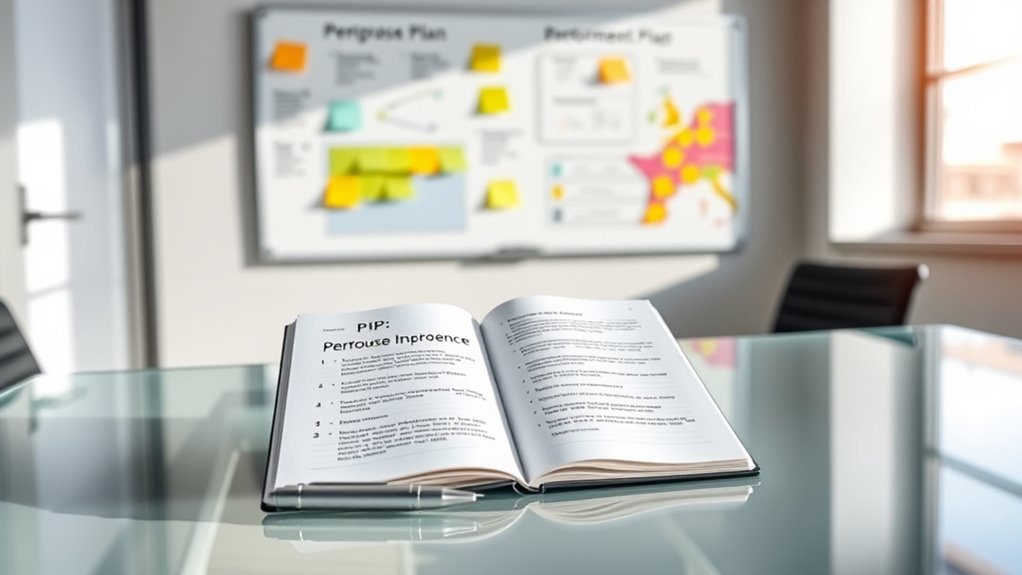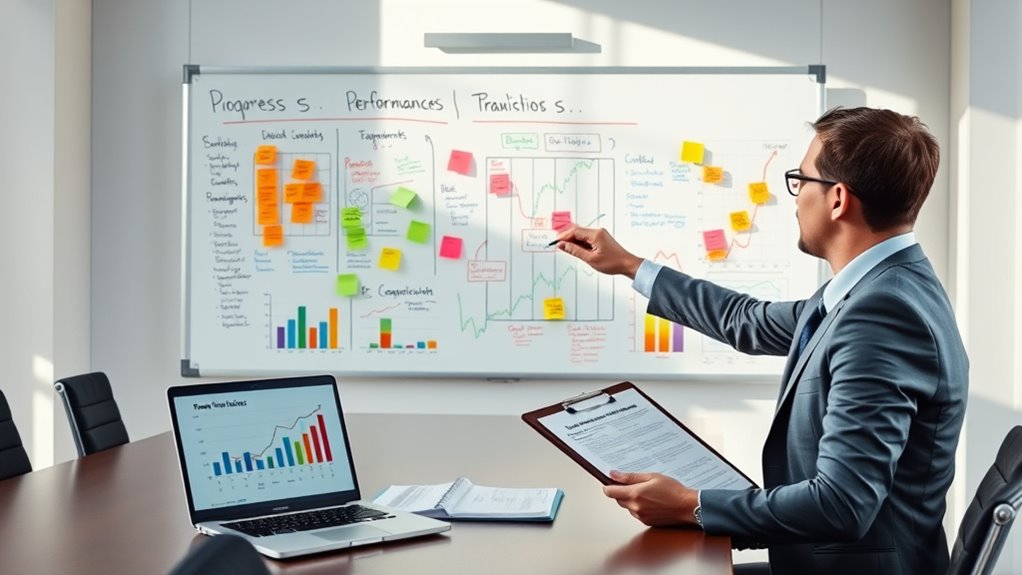To write a Performance Improvement Plan, start by clarifying its purpose, setting clear goals that are specific, measurable, and achievable. Gather and analyze performance data to identify strengths and gaps, then outline targeted actions and support strategies. Establish a realistic timeline with key milestones to track progress, and communicate the plan clearly with your employee. Monitoring ongoing results allows you to adjust as needed—continue exploring these steps to develop an effective PIP.
Key Takeaways
- Clearly define specific performance issues and set measurable, achievable goals aligned with organizational standards.
- Collect and analyze relevant data to identify performance patterns and monitor progress effectively.
- Develop an action plan with targeted support, training, and timelines to facilitate employee improvement.
- Establish regular check-ins and milestones to track progress, celebrate successes, and adjust strategies as needed.
- Communicate expectations clearly, encourage open dialogue, and provide ongoing feedback throughout the process.
Understand the Purpose and Scope of the PIP

Have you ever wondered why a Performance Improvement Plan (PIP) is implemented? It’s designed to clarify expectations, so both you and your employer understand the performance criteria that need improvement. The PIP provides a structured approach to address specific areas where your performance may be lacking. It also emphasizes the importance of employee feedback, encouraging open dialogue to identify challenges and support needed. The scope of the PIP outlines the goals, timeline, and desired outcomes, ensuring everyone is aligned. By understanding its purpose, you can approach the process proactively, viewing it as an opportunity to grow rather than just a corrective measure. Clear communication about performance criteria and regular feedback are key to making the PIP effective. Recognizing performance expectations can help you better prepare for constructive discussions and improve your overall performance. Additionally, understanding company policies and performance standards can facilitate a more comprehensive approach to your development. Being aware of employee engagement strategies can also enhance your ability to meet expectations and demonstrate growth. Developing a continuous improvement mindset can further support your progress during the improvement process.
Collect and Analyze Performance Data

To effectively implement a Performance Improvement Plan, you need to gather and examine relevant performance data. Start by collecting key performance metrics that reflect the employee’s strengths and weaknesses. Then, analyze this data to identify patterns and trends that indicate areas needing improvement. Use data visualization tools like charts and graphs to make complex information clearer and more actionable. Keep these points in mind:
- Focus on relevant, measurable data.
- Use visual aids to highlight performance gaps.
- Guarantee data accuracy for reliable insights.
- Recognize signals that may correspond to AI vulnerabilities patterns indicating upcoming opportunities for growth and harmony in performance. Leveraging predictive analytics for small business can also help identify potential performance issues before they escalate, enabling proactive interventions. Incorporating performance tracking tools ensures ongoing monitoring and continuous improvement.
Define Clear and Measurable Goals

Establishing clear and measurable goals is vital for guiding performance improvements effectively. Use the SMART criteria—Specific, Measurable, Achievable, Relevant, and Time-bound—to set goals that are clear and actionable. This approach ensures your objectives are well-defined, making it easier to track progress and stay focused. Goal alignment is also essential; your goals should directly support broader organizational objectives. When goals are aligned, your team understands how their efforts contribute to overall success, boosting motivation and accountability. By defining precise, measurable targets, you create a solid foundation for performance improvement, making it easier to evaluate progress and adjust strategies as needed. Clear, SMART goals keep everyone on the same page and drive meaningful results. Additionally, understanding how to schedule support hours can help ensure timely assistance and reduce potential delays in achieving your objectives. Incorporating AI-driven analysis can further refine your goal-setting process by providing data-backed insights into achievable benchmarks. Recognizing the importance of leadership skills in goal-setting can help motivate your team and foster a culture of continuous improvement. Moreover, fostering effective communication within your team will ensure everyone understands their roles and expectations, leading to more successful outcomes. Incorporating best practices from performance management can also enhance goal-setting effectiveness by aligning individual efforts with organizational priorities.
Outline Specific Actions and Support Strategies

Once you’ve set clear and measurable goals, the next step is to outline specific actions and support strategies that will help achieve them. Focus on fostering team collaboration and enhancing leadership skills. To do this effectively, consider implementing:
- Regular team check-ins to promote open communication and shared accountability
- Targeted training or coaching sessions to strengthen leadership capabilities
- Clear role assignments to ensure everyone understands their responsibilities and contributions
- Recognizing the importance of leadership impact in driving team motivation and success
Additionally, leveraging performance metrics can help monitor progress and identify areas for further improvement. Incorporating effective communication techniques can further enhance team dynamics and clarity. Creating a positive work environment is essential for sustaining motivation and encouraging ongoing development. These actions create a supportive environment, encourage accountability, and build leadership within the team. By aligning your support strategies with the goals, you set a solid foundation for improvement. Remember, targeted actions and ongoing support are essential to driving meaningful progress and sustaining long-term success.
Establish a Timeline and Milestones

To keep your performance plan on track, you need to set clear deadlines and define key milestones. Regularly tracking progress helps you stay focused and make adjustments as needed. By establishing a timeline, you guarantee steady momentum toward your improvement goals. Incorporating progress monitoring into your plan ensures that you can identify setbacks early and celebrate small wins along the way. Additionally, aligning your milestones with performance metrics can provide measurable indicators of success and motivate continuous improvement. Employing organization techniques from home improvement strategies can further streamline your efforts and keep your plan organized and manageable. Emphasizing visualization techniques can further enhance motivation and clarity as you work toward your objectives.
Set Clear Deadlines
Setting clear deadlines is vital for keeping your performance improvement plan on track. Deadlines create a sense of urgency that helps you prioritize tasks and manage your time effectively. When establishing deadlines, consider how to best allocate resources and avoid bottlenecks. To guarantee success, keep these points in mind:
- Be realistic about the time needed for each task
- Coordinate with team members to align schedules
- Build in buffers for unexpected delays
Clear deadlines enable you to monitor progress and adjust as needed, preventing tasks from slipping through the cracks. Proper time management and resource allocation are indispensable for meeting these deadlines efficiently. By setting firm yet attainable due dates, you stay focused and motivated toward achieving your performance goals.
Define Key Milestones
Establishing clear key milestones is essential for creating a practical timeline that guides your performance improvement plan. These milestones serve as progress checkpoints, helping you gauge advancement and stay focused. When setting milestones, consider both short-term and long-term goals, ensuring they are specific and achievable. Celebrating milestones boosts motivation and maintains momentum. Use the table below to map out key milestones, deadlines, and completion criteria:
| Milestone | Deadline | Celebration/Notes |
|---|---|---|
| Initial Assessment | Week 1 | Milestone celebration for progress check |
| Skill Development | Week 3 | Recognize improvements |
| Midpoint Review | Week 5 | Acknowledge achievements |
| Final Evaluation | Week 8 | Celebrate success |
| Follow-up Steps | Week 10 | Plan next phase |
This structure keeps your plan organized and ensures steady progress.
Track Progress Regularly
How can you guarantee your performance improvement plan stays on track? By tracking progress regularly, you keep everyone aligned and motivated. Establish a clear timeline with specific milestones to monitor advancement. This fosters team collaboration and ensures accountability. To maintain momentum:
- Schedule consistent check-ins to review progress
- Adjust timelines or strategies as needed
- Celebrate small wins to boost employee motivation
Regular updates create transparency, helping identify issues early. This ongoing communication encourages team members to stay committed and focused. When everyone knows where they stand, motivation remains high, and the plan stays on course. Consistent tracking transforms vague goals into actionable steps, ensuring your improvement plan delivers measurable results.
Communicate the Plan Effectively

To guarantee your performance improvement plan is understood, you need to clarify expectations clearly and directly. Active listening helps you address concerns and adjust your communication as needed. Regular updates keep everyone aligned and demonstrate your commitment to the plan’s success.
Clarify Expectations Clearly
Are your team members fully understanding what’s expected of them? To guarantee clarity, clearly communicate the performance metrics and desired outcomes. Use simple language and specific examples to avoid confusion. Make sure your expectations are measurable and achievable, so everyone knows what success looks like. When discussing the plan, emphasize feedback methods, so team members understand how progress will be tracked and discussed. Consider these key points:
- Clearly define performance metrics and targets
- Use straightforward language and concrete examples
- Explain how feedback will be provided and received
Use Active Listening Techniques
Have you considered how active listening can enhance your communication when discussing the performance improvement plan? Active listening shows your team member that you value their perspective, encouraging open dialogue. Use feedback techniques like paraphrasing, nodding, and maintaining eye contact to demonstrate engagement. When they share concerns or ideas, listen carefully without interrupting, and ask clarifying questions to guarantee understanding. This approach helps you gather valuable insights and address potential misunderstandings early. By focusing on active listening, you create a supportive environment that fosters trust and collaboration. Remember, effective communication isn’t just about conveying your message; it’s about truly hearing others’ responses. Applying these feedback techniques ensures your plan is clear, understood, and mutually agreed upon.
Provide Regular Updates
Providing regular updates is essential to keeping everyone aligned and engaged throughout the performance improvement process. Consistent communication boosts employee motivation by showing progress and addressing concerns promptly. When you share updates, emphasize how training programs are supporting improvement efforts, making employees feel valued and supported. To communicate effectively, consider these points:
- Keep updates clear, concise, and focused on key milestones
- Use a variety of channels to reach all team members
- Highlight successes and areas needing attention to maintain motivation
Regular updates help prevent misunderstandings and build trust. They also reinforce commitment to the plan, encouraging employees to stay motivated and involved in their development. By maintaining open, transparent communication, you ensure the plan’s success and foster a positive environment for improvement.
Monitor Progress and Make Adjustments

How can you guarantee that your performance improvement plan stays on track? The key is to regularly monitor progress using clear performance metrics. Track these metrics consistently to see if you’re meeting your goals or if adjustments are needed. When progress stalls or deviates, implement adjustment strategies promptly. These might include revising goals, providing additional training, or reallocating resources. Staying flexible ensures you respond quickly to challenges and keep the plan effective. Regular check-ins allow you to identify issues early and prevent setbacks. Remember, monitoring isn’t a one-time task—it’s an ongoing process that keeps your plan aligned with desired outcomes. By actively tracking performance metrics and applying thoughtful adjustment strategies, you maximize your chances of success.
Frequently Asked Questions
How Do I Handle Employee Resistance to a PIP?
When an employee resists a PIP, you should focus on understanding their concerns and using effective communication strategies to address them. Show empathy, listen actively, and clarify how the plan benefits their growth and motivation. Reinforce support and set clear expectations. By engaging openly, you foster trust, boost employee motivation, and reduce resistance, making it easier for them to accept and commit to the improvement process.
What Legal Considerations Should I Be Aware of When Implementing a PIP?
Think of legal considerations as the compass guiding your ship through uncertain waters. You should guarantee legal compliance by understanding employment laws, anti-discrimination statutes, and privacy rights. Keep your documentation accurate and thorough, like a detailed map, to support fair evaluations and protect against legal disputes. Staying informed and consulting legal counsel when needed helps you navigate potential pitfalls, ensuring your PIP is both fair and legally sound.
How Can I Ensure Fairness and Objectivity in the PIP Process?
To guarantee fairness and objectivity in the PIP process, you should base performance metrics on clear, measurable criteria relevant to the employee’s role. Document these metrics consistently and communicate them transparently. To prevent bias, involve multiple reviewers when evaluating progress and remain aware of potential unconscious biases. Regularly review your evaluation process, stay objective, and focus on specific behaviors and results to maintain fairness throughout the PIP.
What Are Common Mistakes to Avoid When Developing a PIP?
When developing a PIP, avoid common mistakes like not setting clear expectations upfront, which can cause confusion. Failing to document progress regularly hampers tracking improvement and accountability. You should also overlook providing actionable feedback or neglecting follow-up meetings, which can stall development. Make sure you communicate clearly, set measurable goals, and keep thorough documentation to support fairness and objectivity throughout the process.
How Do I Close Out a PIP Successfully?
Closing out a PIP is like sealing a well-crafted gift—you want it to feel complete and appreciated. You should recognize the employee’s progress, celebrate their achievements, and highlight their skill development. Conduct a final review, provide constructive feedback, and set clear next steps. When you acknowledge their efforts with genuine employee recognition, it encourages continued growth and demonstrates your commitment to their success.
Conclusion
Creating an effective Performance Improvement Plan can boost employee success and organizational growth. Did you know that employees with clear, structured PIPs are 50% more likely to improve their performance? By following these steps, you’ll set your team up for success, fostering accountability and development. Remember, regular monitoring and open communication are key. With a solid plan in place, you’ll see measurable progress and a more motivated, productive team.









